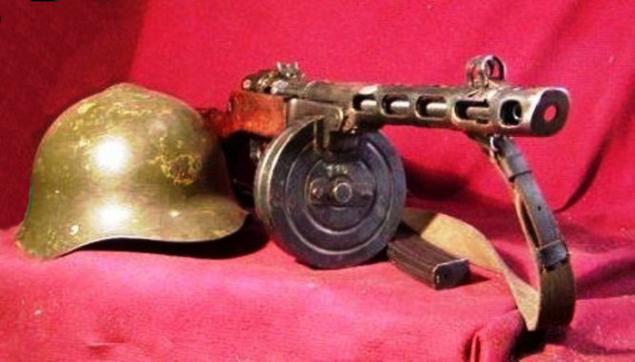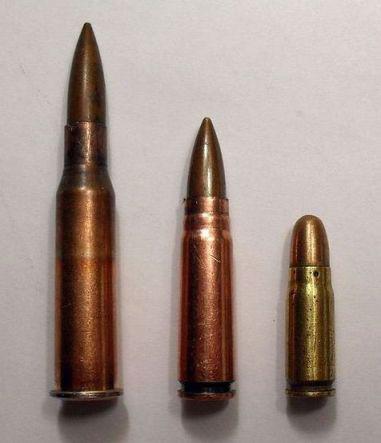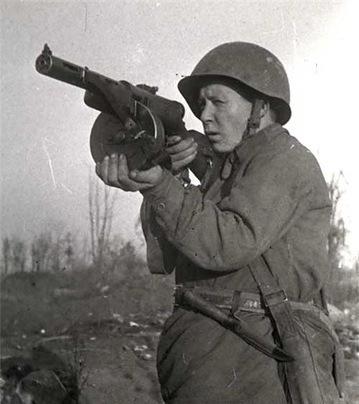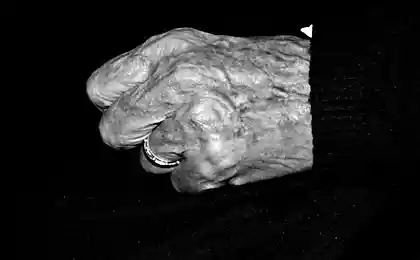1101
Our good old "daddy"
This famous weapon with a characteristic silhouette memorable for us today is the symbol of the Red Army during the Great Patriotic War. Moreover, if a German submachine gun MP-40, for some reason, known here as the "Schmeisser", became a symbol of the Wehrmacht solely through the efforts of actors of cinema, the PCA is a symbol of the Red Army deservedly so, because unlike his German opponent, he played quite a prominent role in fighting the 2nd World War.
22 pictures here

For PCA-41 (submachine gun Shpagin), which Soviet soldiers respectfully called "Dad" in the armed forces and domestic literature is well established completely wrong definition of "automatic". But, as I said in the post of MP-40, the terms "machine" and "machine pistol" refers to a completely different weapons. Automatic - it is rather a lightweight automatic rifle, he shoots shortened and somewhat weakened rifle cartridge, the range of these weapons of destruction - not less (and usually more) of 500 m. A classic example of the machine - our AK, the famous "Kalashnikov". This weapon is universal: with him you can fight in the field, and in close trench. But sub-machine gun fires a weak field for the battlefield pistol cartridge; in fact, this weapon is a weighted and extended automatic pistol. And the affected area from it is only 100-200, at best, a maximum of 300 meters. These weapons are indispensable to fight in the trenches and in the city, but in the field of soldiers armed with submachine guns, almost defenseless against the enemy, armed even obsolete stores, but long-range rifle.
02 cartridges (381x443, 20Kb)
Major domestic cartridges caliber 7, 62 mm:
rifle cartridge "trehlineyki" (case length 54 mm), submachine gun cartridge AK-47 (the length of the sleeve 39 mm) and TT pistol cartridge (case length 25 mm). The difference in the amount of the powder sample and, accordingly, in the power shot is visible to the naked eye.

That is why the Germans never MP-40 armed his infantry, and only betrayed his commanders and tank crews to defend themselves. But the main weapon of the German infantry remained regular store carbine Mauser 98k. Similarly, in the Red Army's main infantry small arms was shoplifting Mosin rifle, the famous "trehlineyka." Nevertheless, the Red Army submachine gun still play a much more prominent role than in the Wehrmacht. If during the existence of the 3rd Reich adopted the German army received about 2 million. Submachine guns of all types (including the trophy), then in the Soviet Union during the same period the industry was transferred to the army more than 6 million. Submachine guns (or "machine "if you follow the wrong, but a very common terminology of national literature, because in the future the real machines it will not go, I still allow myself in this post on the children's Soviet habit is sometimes called a PCA machine). And almost all of these sub-machine guns were actively used in combat, and they were armed not only the commanders and the "techies", but also many of the Marines - in the Red Army were formed whole companies and even battalions "submachine».
So, PCA-41 - the most massive submachine gun 2nd World War, even the most common Western submachine gun at the time - a cheap, simple and primitive, "as the pants of fire", the British "automatic" wall, which was called "the construction of water pipes, "and do any factory for the production of kitchen utensils, was released in the amount of" only "4 million. pieces. A PCA, which is due to its high technology as well could produce any factory cooking pots, only in 1941-1945. It was manufactured and delivered to the troops of 5, 4 mln. pieces; Overall, until the end of production in 1947 PCA was made 6 million. copies. He is rightly recognized as one of the best submachine guns 2nd World War.
03 STEN Mk III (700x349, 12Kb)
British WALLS - the most massive foreign SMG times 2nd World War

Preceded by "Papa" - "Degtar»
However, like any other extraordinary phenomenon, the PCA did not appear "suddenly and immediately." And he, like any other masterpiece, had its predecessors, which determined its existence to the emergence of a recognized "King." And before the PCA in the Red Army was in service with other SMGs - PPD, which determined the main advantages of the PCA, and showed deficiencies that need to be addressed in order to become "the main Soviet automatic" 2nd World War.

Preceded by the PCA sub-machine gun Degtyarev (PPD) was adopted by the Red Army in 1934 (version PDP-34). Among the many other employees of the design bureau VA Degtyareva on a new sample worked and GS Shpagin - the future creator of "Papa." It was a time when the military leadership of the majority of countries apply to this type of weapon dismissive, considering sub-machine guns, "guns gangsters." However, some states, such as Austria, Germany and the Soviet Union in those years became interested in automatic weapons and change their attitude to it - under the influence of information about successful combat use submachine guns in the war against Paraguay, Bolivia (1932-1936 gg.), And then - in the Spanish Civil War (1936-1939 gg.). Both these wars were fought in quite specific conditions: Bolivian-Paraguayan war - in a densely wooded area, and Spanish - in mountainous areas and in the cities; in these circumstances, opponents often met each other at very close range, and sub-machine guns were able to show the full power of your melee.
Submachine gun Degtyarev - an early version of the PDP-34

Adopted by the Red Army PDP-34 is a structure, the effect of which was based on the recoil free shutter at a fixed barrel. Pressure powder gases when firing threw the bolt in the rear position; thus extracted from the chamber cartridge cases and compresses the return spring shutter. Then, under the action of the spring gate rushed forward, removing the cartridge from the magazine and forcing it into the chamber, a strong blow piercing to the most forward position the striker, welded into the cup gate cap, which led to the next shot. It is this principle of action was subsequently used in the PCA-41. Like the hero of our story, his predecessor, PPD has been adapted to fire a powerful 7, 62h25 mm ammunition from pistols TT-33 which is a modification of well-proven in the battles of the 1st World War Mauser pistol cartridge. But the PDP, in contrast to his future competitor, cartridges were placed in a box magazine capacity of 25 pieces. The power of long-range TT cartridge will produce new weapons fire from a much greater distance than they could afford large-caliber submachine guns in other countries; PPD was therefore the sight of sector type, designed for firing at a distance up to 500 meters (instead of 100-200 meters, as in the foreign samples)! In addition, the PDP-34 had the opportunity to fire both turns, and single shots, which was installed on the weapon translator fire. However, when automatic fire PPD much bouncing on impact, resulting in a low accuracy of fire and a reduced range of impact the fight up to 300 meters, but this distance and was unattainable for foreign SMGs. But technologically PDI was quite complicated and expensive to manufacture, since most of its parts is fabricated as usual for the time of machine metalworking method that also determines the considerable weight and arms. PDI complex was in the process of disassembly-assembly, which required the presence of special tools; This process was not only difficult, but also durable, virtually eliminating rectify faults weapons in conditions of combat.
As experience in the use of these weapons in the Red Army is still not available, PDP-34 was produced in small quantities at first. I get it only commander who submachine gun was to serve as protection on the battlefield. As a result of the use of the new weapons in the army with the 1937 production of PDP became more widespread, and in 1938 passed a partial modernization of PPD (primarily improved fixing slightly store and changed the technology of production); new weapons received coded PDP-34/38. Generally, submachine guns at the time the Red Army was still very small, and many experts were looking at them as a luxury with a very questionable tactical opportunities: the fighting qualities of PDP has not yet been tested in battle, and remained fairly vague, but the cost of the machine was a record for small arms. For prices in 1936 alone PDP-34 costs the state as much as 1,350 rubles, while the 7, 62-mm rifle arr. 1891/1930 years. Army worth 90 rubles, the revolver Nagant - 50 rubles, and the machine gun Degtyaryov DP-27 was significantly superior on PDI combat capabilities - only 787 rubles.
Perhaps that is why many studies have asserted that the alleged while the Soviet command applied to the sub-machine gun in the negative, and in 1939 production was completely discontinued PPD and all machines were delivered to the warehouses. But in fact it was not quite like that. The interest of command to a new type of weapon not faded, simple operation PPD in the army revealed its many technical flaws, and arms production was temporarily suspended - "to troubleshoot" and the available samples sent for revision.
Began in November 1939, the Soviet-Finnish war has stirred up a wave of special interest to the sub-machine guns. Although, contrary to the tales of journalists who moved in serious research literature, Finnish soldiers were not "polls armed with machine guns," Suomi (statewide in the Finnish infantry regiment numbering 3,000 people, there were only 72 submachine gun), the conditions of combat in the dense forests allow this weapons show their full strength. Command of the Red Army, under the influence of panic infect reports of some commanders and numerous newspaper articles "hack writers" "avtomatoboyaznyu" urgently required to transfer to the area of fighting all available PPD and insisted on transferring the production of submachine guns on three-shift operation. Newly produced directly from the PDP party shops immediately sent to the front ...
Upgraded PDP-34/38 disk magazine 71 cartridge

Fighting in the snowy forests of Finland have shown that enemy soldiers, armed Suomi equipped with large disk stores 70 rounds, could considerably longer to conduct continuous fire, than the Soviet soldiers whose PPD had a 25-round magazine, and it is an advantage in transient neighbors fights often become decisive. And then came the command to hold the next upgrade submachine gun Degtyarev, paying attention in the first place to create a roomy storage to store (insisted on personally IV Stalin). The result is a disc spring store 71 cartridge, while the new version of the PDP-40 receiver box has been adapted only for this disc. But before the PDP-40 has been put into mass production, already had armed PDP-34 and PDP-34/38 were equipped with a somewhat modified version of the disc store - with special elongated neck, allows you to insert round disc into the hole for the rectangular box magazine . The use of disk stores in the Soviet submachine gun was comprehensive, despite the fact that they were bulky, inconvenient to use and very expensive and time consuming to manufacture.
Soviet disc magazine 71 cartridge for DPP and PCA - bulky and inconvenient to use design

The new version of submachine gun Degtyarev was launched in a series of even during the Russo-Finnish War - in February 1940; PDP-40 produced more massive than its previous versions. If the PDP-34 and -34 / 38 for 5 years, was released a total of slightly more than 4 million pieces, the PDP-40 to the end of its production in 1941 (that is, the total for the year) managed to produce nearly 87,000 copies. And yet, according to the country's leadership, it was too little - for a future major war PDP was not fit; Red Army needed more technological and cheap machine pistol, which would be possible to produce millions of copies. As a result, the People's Commissariat of armaments turned to arms makers with the request to create a new high-tech "machine", the details of which would require a minimum of machining. It was then that the cause and took
PDP-40 - the most successful version of "Degtyar", but rather in the production of non-technological

Daddy "enters the fray
George S. Shpagin knew all the advantages and disadvantages of the PDP on the creation of which he has worked, among other designers - under the guidance of his teacher Vasily Alekseyevich Degtyaryov. Therefore Shpagin decided to use their weapons in the most successful designs PPD, revised and changed his bad nodes. But the main issue was to change the technology of weapons to the new machine could "stamp as a spoon." That decision and accepted S. George: the vast majority of the details of its weapons are manufactured by cold stamping of sheet steel - a solution for that time innovative, yet almost never used in the production of weapons anywhere in the world. The Germans tried this method in its experimental submachine gun ERMA.36, but at a mass version MR.38 they returned to the machined.
George S. Shpagin - creator of the famous "Papa»

This new technology for that time, applied Shpagin in his arms, greatly reduce the labor intensity of production and material sub-machine gun, allowing the use of cheap and abundant materials, which, in turn, several times reduced the cost of the future PCA. In fact, only the trunk was exposed to careful processing to machine tools - it has become the main advantage of the "king of the Soviet machine." Simply and cheaply solved in the same issue of the compound produced parts - by spot welding and riveting. As a result, the PCA has been very useful in the field of assembly-disassembly: it can be quickly disassembled without tools, since the weapon was not one of the screw connections - for deconstruction was enough only to unfasten the clasp finger. New sub-machine gun, as well as PPD translator who had an automatic and a single lamp, was designed for the use of the same 7, 62h25 mm rounds from pistols TT-33. The cartridges were placed in the disk 71-round magazine, taken without any change from the PDP-40; perhaps it was one of the most expensive and complex nodes in the design. Through the use of a cartridge from the TT-33 PCA retains the power of fire, characteristic of the PDP, but the designer was able to raise his arms shooting accuracy by 70%. For this Shpagin had to re-design the shape of the barrel jacket. It ended muzzle compensator original whose front wall (with a hole for the passage of a bullet) has been welded at an angle to the axis of the barrel. When fired, the powder gases hit in the sloping wall, reducing the force of impact and preventing uneven impact Pitching the trunk up. As a result of the firing of the PCA became very heap that really possible to increase the range of a single sighting shot up to 500 meters - a distance that is unique to the submachine guns (PCA therefore preserved sector sight of PPD). Another "trick" the PCA was the shock absorber valve located behind the back-mainspring. It was intended to reduce vibration when the shutter moves back, as well as improve the survivability of the shutter and the receiver. At first, this shock was made of rubber. However, during the war delivery rubber fell sharply, becoming scarce; In addition, with the onset of winter, it became clear that because of the severe frosts rubber shock absorber "dubeet" and crack. Then the shock absorbers for the PCA from the beginning of 1942 were made from the skin, which proved to be more reliable and unpretentious.
PCA-41 - submachine gun Shpagin in pre-war version (with sectoral gun, designed for shooting up to 500 m

Another feature of the machine pistol Shpagin, which in Russian literature to be proud of, it was an extremely high rate of fire - 1000 rounds per minute. This is an absolute champion in the ranks of all the submachine guns 2nd World: Still, 1000 Venue. / Min. against 800 Venue. / min. at 500 RPM and rds. / min. from German MR.38. However, whether this is really proud of - the big question. No wonder the soldiers PCA earned the nickname "the devourer of ammunition." On the one hand, at this rate, you can quickly literally "lard" lead goal reliably "off" it.
ALL
Source:
22 pictures here

For PCA-41 (submachine gun Shpagin), which Soviet soldiers respectfully called "Dad" in the armed forces and domestic literature is well established completely wrong definition of "automatic". But, as I said in the post of MP-40, the terms "machine" and "machine pistol" refers to a completely different weapons. Automatic - it is rather a lightweight automatic rifle, he shoots shortened and somewhat weakened rifle cartridge, the range of these weapons of destruction - not less (and usually more) of 500 m. A classic example of the machine - our AK, the famous "Kalashnikov". This weapon is universal: with him you can fight in the field, and in close trench. But sub-machine gun fires a weak field for the battlefield pistol cartridge; in fact, this weapon is a weighted and extended automatic pistol. And the affected area from it is only 100-200, at best, a maximum of 300 meters. These weapons are indispensable to fight in the trenches and in the city, but in the field of soldiers armed with submachine guns, almost defenseless against the enemy, armed even obsolete stores, but long-range rifle.
02 cartridges (381x443, 20Kb)
Major domestic cartridges caliber 7, 62 mm:
rifle cartridge "trehlineyki" (case length 54 mm), submachine gun cartridge AK-47 (the length of the sleeve 39 mm) and TT pistol cartridge (case length 25 mm). The difference in the amount of the powder sample and, accordingly, in the power shot is visible to the naked eye.

That is why the Germans never MP-40 armed his infantry, and only betrayed his commanders and tank crews to defend themselves. But the main weapon of the German infantry remained regular store carbine Mauser 98k. Similarly, in the Red Army's main infantry small arms was shoplifting Mosin rifle, the famous "trehlineyka." Nevertheless, the Red Army submachine gun still play a much more prominent role than in the Wehrmacht. If during the existence of the 3rd Reich adopted the German army received about 2 million. Submachine guns of all types (including the trophy), then in the Soviet Union during the same period the industry was transferred to the army more than 6 million. Submachine guns (or "machine "if you follow the wrong, but a very common terminology of national literature, because in the future the real machines it will not go, I still allow myself in this post on the children's Soviet habit is sometimes called a PCA machine). And almost all of these sub-machine guns were actively used in combat, and they were armed not only the commanders and the "techies", but also many of the Marines - in the Red Army were formed whole companies and even battalions "submachine».
So, PCA-41 - the most massive submachine gun 2nd World War, even the most common Western submachine gun at the time - a cheap, simple and primitive, "as the pants of fire", the British "automatic" wall, which was called "the construction of water pipes, "and do any factory for the production of kitchen utensils, was released in the amount of" only "4 million. pieces. A PCA, which is due to its high technology as well could produce any factory cooking pots, only in 1941-1945. It was manufactured and delivered to the troops of 5, 4 mln. pieces; Overall, until the end of production in 1947 PCA was made 6 million. copies. He is rightly recognized as one of the best submachine guns 2nd World War.
03 STEN Mk III (700x349, 12Kb)
British WALLS - the most massive foreign SMG times 2nd World War

Preceded by "Papa" - "Degtar»
However, like any other extraordinary phenomenon, the PCA did not appear "suddenly and immediately." And he, like any other masterpiece, had its predecessors, which determined its existence to the emergence of a recognized "King." And before the PCA in the Red Army was in service with other SMGs - PPD, which determined the main advantages of the PCA, and showed deficiencies that need to be addressed in order to become "the main Soviet automatic" 2nd World War.

Preceded by the PCA sub-machine gun Degtyarev (PPD) was adopted by the Red Army in 1934 (version PDP-34). Among the many other employees of the design bureau VA Degtyareva on a new sample worked and GS Shpagin - the future creator of "Papa." It was a time when the military leadership of the majority of countries apply to this type of weapon dismissive, considering sub-machine guns, "guns gangsters." However, some states, such as Austria, Germany and the Soviet Union in those years became interested in automatic weapons and change their attitude to it - under the influence of information about successful combat use submachine guns in the war against Paraguay, Bolivia (1932-1936 gg.), And then - in the Spanish Civil War (1936-1939 gg.). Both these wars were fought in quite specific conditions: Bolivian-Paraguayan war - in a densely wooded area, and Spanish - in mountainous areas and in the cities; in these circumstances, opponents often met each other at very close range, and sub-machine guns were able to show the full power of your melee.
Submachine gun Degtyarev - an early version of the PDP-34

Adopted by the Red Army PDP-34 is a structure, the effect of which was based on the recoil free shutter at a fixed barrel. Pressure powder gases when firing threw the bolt in the rear position; thus extracted from the chamber cartridge cases and compresses the return spring shutter. Then, under the action of the spring gate rushed forward, removing the cartridge from the magazine and forcing it into the chamber, a strong blow piercing to the most forward position the striker, welded into the cup gate cap, which led to the next shot. It is this principle of action was subsequently used in the PCA-41. Like the hero of our story, his predecessor, PPD has been adapted to fire a powerful 7, 62h25 mm ammunition from pistols TT-33 which is a modification of well-proven in the battles of the 1st World War Mauser pistol cartridge. But the PDP, in contrast to his future competitor, cartridges were placed in a box magazine capacity of 25 pieces. The power of long-range TT cartridge will produce new weapons fire from a much greater distance than they could afford large-caliber submachine guns in other countries; PPD was therefore the sight of sector type, designed for firing at a distance up to 500 meters (instead of 100-200 meters, as in the foreign samples)! In addition, the PDP-34 had the opportunity to fire both turns, and single shots, which was installed on the weapon translator fire. However, when automatic fire PPD much bouncing on impact, resulting in a low accuracy of fire and a reduced range of impact the fight up to 300 meters, but this distance and was unattainable for foreign SMGs. But technologically PDI was quite complicated and expensive to manufacture, since most of its parts is fabricated as usual for the time of machine metalworking method that also determines the considerable weight and arms. PDI complex was in the process of disassembly-assembly, which required the presence of special tools; This process was not only difficult, but also durable, virtually eliminating rectify faults weapons in conditions of combat.
As experience in the use of these weapons in the Red Army is still not available, PDP-34 was produced in small quantities at first. I get it only commander who submachine gun was to serve as protection on the battlefield. As a result of the use of the new weapons in the army with the 1937 production of PDP became more widespread, and in 1938 passed a partial modernization of PPD (primarily improved fixing slightly store and changed the technology of production); new weapons received coded PDP-34/38. Generally, submachine guns at the time the Red Army was still very small, and many experts were looking at them as a luxury with a very questionable tactical opportunities: the fighting qualities of PDP has not yet been tested in battle, and remained fairly vague, but the cost of the machine was a record for small arms. For prices in 1936 alone PDP-34 costs the state as much as 1,350 rubles, while the 7, 62-mm rifle arr. 1891/1930 years. Army worth 90 rubles, the revolver Nagant - 50 rubles, and the machine gun Degtyaryov DP-27 was significantly superior on PDI combat capabilities - only 787 rubles.
Perhaps that is why many studies have asserted that the alleged while the Soviet command applied to the sub-machine gun in the negative, and in 1939 production was completely discontinued PPD and all machines were delivered to the warehouses. But in fact it was not quite like that. The interest of command to a new type of weapon not faded, simple operation PPD in the army revealed its many technical flaws, and arms production was temporarily suspended - "to troubleshoot" and the available samples sent for revision.
Began in November 1939, the Soviet-Finnish war has stirred up a wave of special interest to the sub-machine guns. Although, contrary to the tales of journalists who moved in serious research literature, Finnish soldiers were not "polls armed with machine guns," Suomi (statewide in the Finnish infantry regiment numbering 3,000 people, there were only 72 submachine gun), the conditions of combat in the dense forests allow this weapons show their full strength. Command of the Red Army, under the influence of panic infect reports of some commanders and numerous newspaper articles "hack writers" "avtomatoboyaznyu" urgently required to transfer to the area of fighting all available PPD and insisted on transferring the production of submachine guns on three-shift operation. Newly produced directly from the PDP party shops immediately sent to the front ...
Upgraded PDP-34/38 disk magazine 71 cartridge

Fighting in the snowy forests of Finland have shown that enemy soldiers, armed Suomi equipped with large disk stores 70 rounds, could considerably longer to conduct continuous fire, than the Soviet soldiers whose PPD had a 25-round magazine, and it is an advantage in transient neighbors fights often become decisive. And then came the command to hold the next upgrade submachine gun Degtyarev, paying attention in the first place to create a roomy storage to store (insisted on personally IV Stalin). The result is a disc spring store 71 cartridge, while the new version of the PDP-40 receiver box has been adapted only for this disc. But before the PDP-40 has been put into mass production, already had armed PDP-34 and PDP-34/38 were equipped with a somewhat modified version of the disc store - with special elongated neck, allows you to insert round disc into the hole for the rectangular box magazine . The use of disk stores in the Soviet submachine gun was comprehensive, despite the fact that they were bulky, inconvenient to use and very expensive and time consuming to manufacture.
Soviet disc magazine 71 cartridge for DPP and PCA - bulky and inconvenient to use design

The new version of submachine gun Degtyarev was launched in a series of even during the Russo-Finnish War - in February 1940; PDP-40 produced more massive than its previous versions. If the PDP-34 and -34 / 38 for 5 years, was released a total of slightly more than 4 million pieces, the PDP-40 to the end of its production in 1941 (that is, the total for the year) managed to produce nearly 87,000 copies. And yet, according to the country's leadership, it was too little - for a future major war PDP was not fit; Red Army needed more technological and cheap machine pistol, which would be possible to produce millions of copies. As a result, the People's Commissariat of armaments turned to arms makers with the request to create a new high-tech "machine", the details of which would require a minimum of machining. It was then that the cause and took
PDP-40 - the most successful version of "Degtyar", but rather in the production of non-technological

Daddy "enters the fray
George S. Shpagin knew all the advantages and disadvantages of the PDP on the creation of which he has worked, among other designers - under the guidance of his teacher Vasily Alekseyevich Degtyaryov. Therefore Shpagin decided to use their weapons in the most successful designs PPD, revised and changed his bad nodes. But the main issue was to change the technology of weapons to the new machine could "stamp as a spoon." That decision and accepted S. George: the vast majority of the details of its weapons are manufactured by cold stamping of sheet steel - a solution for that time innovative, yet almost never used in the production of weapons anywhere in the world. The Germans tried this method in its experimental submachine gun ERMA.36, but at a mass version MR.38 they returned to the machined.
George S. Shpagin - creator of the famous "Papa»

This new technology for that time, applied Shpagin in his arms, greatly reduce the labor intensity of production and material sub-machine gun, allowing the use of cheap and abundant materials, which, in turn, several times reduced the cost of the future PCA. In fact, only the trunk was exposed to careful processing to machine tools - it has become the main advantage of the "king of the Soviet machine." Simply and cheaply solved in the same issue of the compound produced parts - by spot welding and riveting. As a result, the PCA has been very useful in the field of assembly-disassembly: it can be quickly disassembled without tools, since the weapon was not one of the screw connections - for deconstruction was enough only to unfasten the clasp finger. New sub-machine gun, as well as PPD translator who had an automatic and a single lamp, was designed for the use of the same 7, 62h25 mm rounds from pistols TT-33. The cartridges were placed in the disk 71-round magazine, taken without any change from the PDP-40; perhaps it was one of the most expensive and complex nodes in the design. Through the use of a cartridge from the TT-33 PCA retains the power of fire, characteristic of the PDP, but the designer was able to raise his arms shooting accuracy by 70%. For this Shpagin had to re-design the shape of the barrel jacket. It ended muzzle compensator original whose front wall (with a hole for the passage of a bullet) has been welded at an angle to the axis of the barrel. When fired, the powder gases hit in the sloping wall, reducing the force of impact and preventing uneven impact Pitching the trunk up. As a result of the firing of the PCA became very heap that really possible to increase the range of a single sighting shot up to 500 meters - a distance that is unique to the submachine guns (PCA therefore preserved sector sight of PPD). Another "trick" the PCA was the shock absorber valve located behind the back-mainspring. It was intended to reduce vibration when the shutter moves back, as well as improve the survivability of the shutter and the receiver. At first, this shock was made of rubber. However, during the war delivery rubber fell sharply, becoming scarce; In addition, with the onset of winter, it became clear that because of the severe frosts rubber shock absorber "dubeet" and crack. Then the shock absorbers for the PCA from the beginning of 1942 were made from the skin, which proved to be more reliable and unpretentious.
PCA-41 - submachine gun Shpagin in pre-war version (with sectoral gun, designed for shooting up to 500 m

Another feature of the machine pistol Shpagin, which in Russian literature to be proud of, it was an extremely high rate of fire - 1000 rounds per minute. This is an absolute champion in the ranks of all the submachine guns 2nd World: Still, 1000 Venue. / Min. against 800 Venue. / min. at 500 RPM and rds. / min. from German MR.38. However, whether this is really proud of - the big question. No wonder the soldiers PCA earned the nickname "the devourer of ammunition." On the one hand, at this rate, you can quickly literally "lard" lead goal reliably "off" it.
ALL
Source:





















